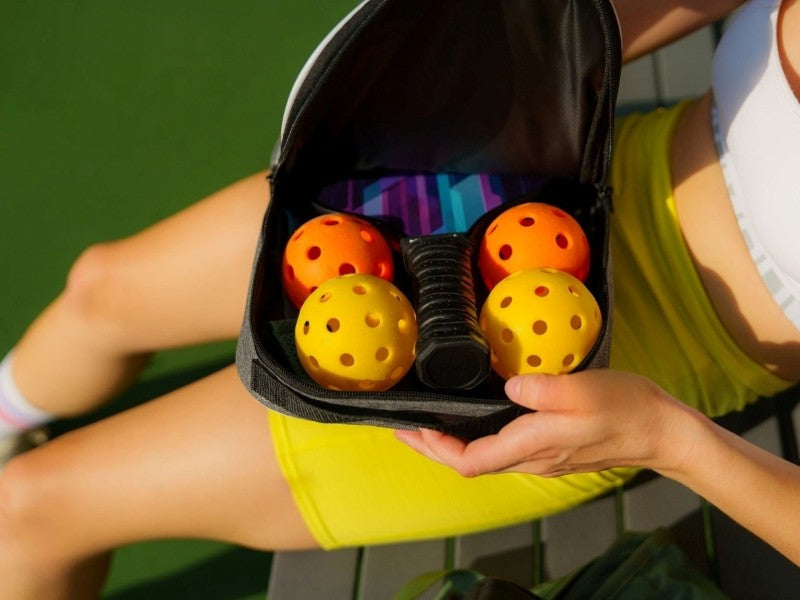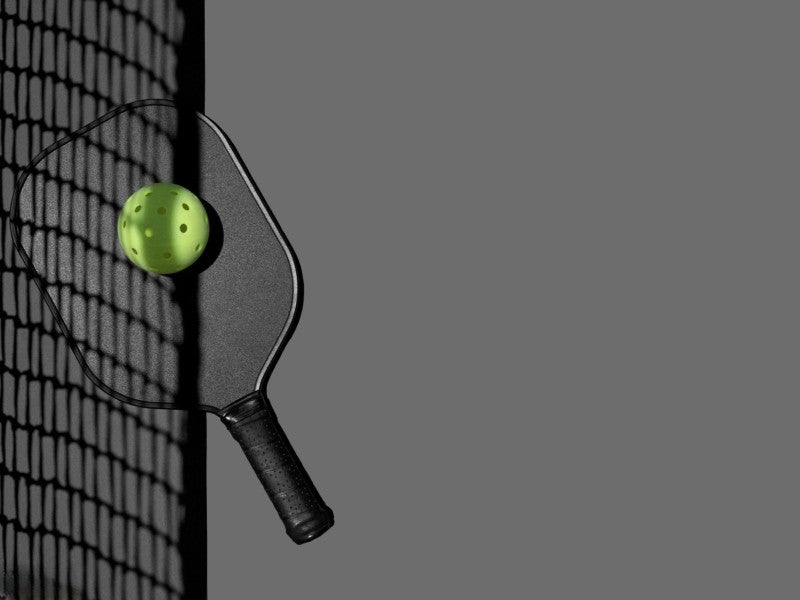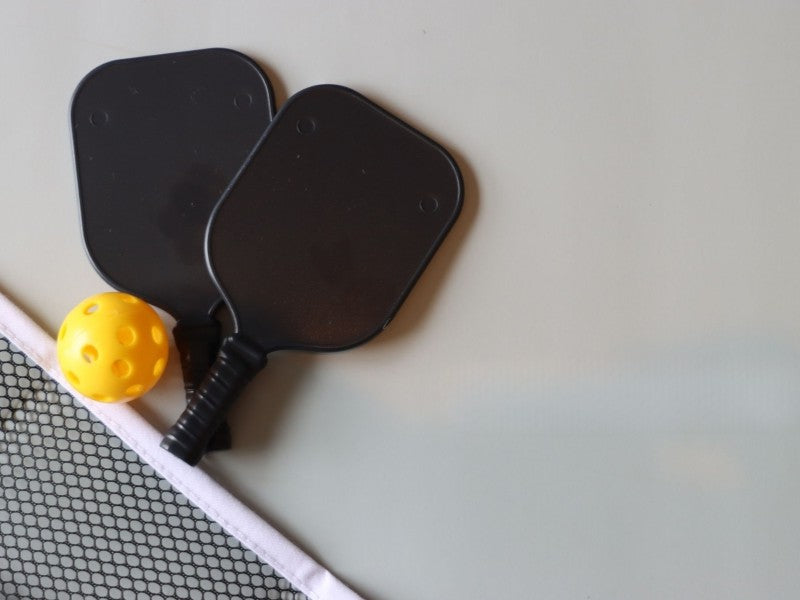If you’ve ever played pickleball outdoors on a hot summer afternoon and then again on a cool winter morning, you may have noticed something unusual — your shots just don’t feel the same. The bounce is lower, the speed changes, and sometimes the ball even cracks faster than expected. This isn’t your imagination.
In fact, different types of pickleball balls react very differently to changes in weather. From temperature to humidity, from sunlight to wind, the environment plays a crucial role in how each ball performs on the court.
Key Takeaways
· Weather changes everything — heat, cold, humidity, and wind directly influence bounce height, flight path, and control.
· Outdoor balls (harder plastic, more holes) perform best in stable, warm conditions but become brittle in cold weather.
· Indoor balls (softer and lighter) are less affected by temperature but struggle in strong winds.
· Material type, hole pattern, and seam design determine how well a ball resists cracking, absorbs energy, and maintains flight stability.
· Proper storage and pre-match temperature adjustment can significantly extend a ball’s lifespan and consistency.
Main Types of Pickleball Balls and Their Core Traits
Understanding the types of pickleball balls helps players make informed decisions when facing different playing environments. Below are the main categories and how each one behaves in typical conditions.
1. Indoor Pickleball Balls
Construction & Traits:
· Made from softer plastic with 26 larger holes.
· Designed for low bounce and excellent control.
· Quieter and easier to manage in rallies.
Performance Notes:
· Excellent for gyms and climate-controlled courts.
· Bounce remains relatively consistent in moderate humidity and temperature.
· In outdoor play, large holes make them unstable in wind, and soft material wears faster on rough surfaces.
Ideal Environment:
Stable indoor temperatures, low air currents, and smooth hardwood or vinyl surfaces.

2. Outdoor Pickleball Balls
Construction & Traits:
· Built with harder polymers for resistance against abrasions and impact.
· Feature 40 small holes, engineered for wind control and aerodynamic balance.
· Produce a louder “pop” sound and travel faster.
Performance Notes:
· Perform best in dry, warm climates with moderate wind.
· In cold conditions, can become brittle and prone to cracking.
· Excessive heat may soften plastic slightly, making balls “mushy” and bouncy.
Ideal Environment:
Outdoor concrete or asphalt courts, warm temperatures (15–30°C / 59–86°F).
3. Tournament or Premium Balls
Construction & Traits:
· Usually seamless, high-quality resin, consistent weight distribution.
· Balanced between indoor and outdoor specs — optimized for speed and precision.
· Meet USA Pickleball standards for competition.
Performance Notes:
· Provide predictable play across moderate temperature ranges.
· Used in official tournaments where consistency and durability are key.
· Costlier, but the lifespan and uniformity justify the price.
Ideal Environment:
Moderate climates; suitable for both indoor and outdoor tournament settings.
4. Practice and Training Balls
Construction & Traits:
· Made for endurance and cost-efficiency.
· May not meet official size or weight specs.
· Sometimes heavier or softer for repetitive drills.
Performance Notes:
· Not designed for competitive play but ideal for skill development.
· Weather sensitivity depends on material quality; often poor performance in extreme temperatures.
Ideal Environment:
Mild, dry weather or indoor training sessions.
How Weather Affects the Performance of Pickleball Balls
Environmental conditions significantly impact how types of pickleball balls behave during play. Let’s examine how each factor — temperature, humidity, wind, and sunlight — influences performance in real matches.
1. Temperature: The Biggest Variable
Temperature changes can alter both material stiffness and air density, directly affecting bounce, flight, and durability.
· Hot Weather (>30°C / 86°F):
o The plastic softens, causing the ball to bounce higher and travel faster.
o Over time, exposure to extreme heat can deform the shape and make the ball feel “mushy.”
o Outdoor balls generally tolerate heat better but still lose roundness with prolonged exposure.
· Cold Weather (<10°C / 50°F):
o The polymer hardens and becomes brittle, leading to reduced bounce and increased cracking risk.
o Hard surfaces amplify these effects — a cold outdoor court can break a ball after just a few games.
o Indoor balls perform slightly better in cold due to softer material composition.
Practical Tip:
Warm your pickleball balls indoors before cold-weather play. A 10–15 minute temperature adjustment can prevent cracking and restore bounce consistency.
2. Humidity and Moisture
Humidity changes air resistance and surface interaction:
· High humidity increases air density, slightly slowing down ball flight.
· Moisture on the ball reduces friction with the paddle, resulting in less spin and control.
· Wet courts cause balls to skid instead of bounce — significantly altering rally rhythm.
Observation:
Outdoor balls with smaller holes handle moisture better than indoor balls because water disperses more evenly. However, prolonged play in damp conditions still accelerates wear.
3. Wind and Air Movement
Wind interacts strongly with ball hole patterns:
· Outdoor balls with 40 small holes are more resistant to wind turbulence.
· Indoor balls with 26 large holes act almost like “mini sails” — unpredictable in gusty environments.
Side Wind Effects:
Wind from the side amplifies curve and trajectory drift, especially when using spin shots. The lighter the ball, the more noticeable the deviation.
Mitigation:
Players often compensate with flatter, lower drives or use heavier outdoor balls in breezy conditions.
4. Sunlight and UV Exposure
While often overlooked, sunlight and ultraviolet radiation gradually degrade plastic integrity:
· UV rays break down polymer chains, causing color fading and surface brittleness.
· Long exposure (especially in high-altitude or coastal regions) leads to uneven hardness and cracking.
· Seamless, UV-stabilized balls retain shape and color longer.
Storage Tip:
Always store your pickleball balls in a cool, shaded area or covered bag — never in a hot car trunk or under direct sunlight for extended periods.
5. Altitude and Air Density
At higher altitudes, air is thinner, meaning less drag and faster ball speeds.
· Players in mountain regions may notice outdoor balls flying longer distances.
· Indoor balls (softer and slower) can help regain control at high altitudes.

Testing and Measuring Performance Across Weather Conditions
Understanding the theory behind temperature, wind, and humidity is one thing — but how do we actually measure how different types of pickleball balls perform in various weather environments?
Sports engineers, clubs, and even major manufacturers use a combination of lab simulations and real-world testing to analyze performance differences.
1. Bounce Height and Temperature Testing
One of the most revealing tests involves measuring bounce height at different temperatures.
· In controlled settings, a ball is dropped from a height of 78 inches (2 meters) onto a hard surface.
· The rebound height is recorded across multiple temperature points — such as 5°C (41°F), 20°C (68°F), and 35°C (95°F).
Typical results:
· Indoor balls maintain roughly 80–85% rebound height consistency across temperatures.
· Outdoor balls may show a 10–15% variance, bouncing significantly higher in warm conditions and lower in cold ones.
This demonstrates that outdoor balls, while more durable, are more temperature-sensitive due to their harder polymer shells.
2. Wind Tunnel Aerodynamic Analysis
Wind tunnels are used to simulate how hole pattern and weight distribution influence stability.
When tested under 10–20 km/h (6–12 mph) airflow:
· Outdoor balls with 40 smaller holes maintain trajectory with less than 3° deviation,
· Indoor balls with 26 larger holes can deviate up to 10° or more, especially in crosswinds.
Interpretation:
Outdoor designs perform more reliably in windy weather, but at the expense of requiring slightly more paddle control to generate spin.
3. Durability and Crack Resistance Tests
Balls are mechanically struck against concrete surfaces using controlled force (measured in Newtons) to simulate gameplay fatigue.
After 200–300 impacts, engineers inspect for crack formation, shape deformation, and color fade.
Results show:
· Seamless outdoor balls outperform seamed ones in cold weather conditions by up to 40% in lifespan.
· Indoor balls typically lose roundness faster under heat or humidity due to their softer resin composition.
Choosing the Right Ball for Your Climate
With so many types of pickleball balls available, selecting the right one for your playing environment is essential for consistent performance. Below is a guide summarizing which ball types perform best under different weather and court conditions.
|
Condition |
Recommended Ball Type |
Reason |
|
Hot & Dry (Over 30°C / 86°F) |
Seamless outdoor ball |
Harder plastic resists deformation; stable flight |
|
Cold (Below 10°C / 50°F) |
Indoor or soft-polymer outdoor ball |
Softer composition resists cracking |
|
High Humidity / Coastal Climate |
Outdoor ball with UV protection |
Handles moisture better and resists UV degradation |
|
Windy Regions |
40-hole outdoor ball |
Greater aerodynamic stability |
|
Indoor Gyms or Controlled Courts |
26-hole indoor ball |
Better touch and quieter performance |
|
High Altitude (>1,500m) |
Indoor or hybrid ball |
Helps control excessive flight speed |
|
Rainy / Damp Weather |
Avoid play or use waterproof outdoor training ball |
Minimizes skid and slippage |
By understanding the conditions you play in most often, you can maintain better shot control, improve rally quality, and extend ball lifespan.
Real-World Examples: Performance by Climate Zone
Let’s see how various types of pickleball balls perform in real-world conditions across popular pickleball regions.
1. Florida (Hot and Humid)
Players often report that harder outdoor balls become soft and lose bounce quickly.
Recommended: UV-resistant outdoor balls with thicker walls (e.g., seamless tournament models).
2. Arizona (Hot and Dry Desert)
High UV exposure and dry air can fade color and degrade material.
Recommended: Heat-resistant outdoor balls stored in shaded coolers.
3. Pacific Northwest (Cool and Damp)
Cold rain and humidity cause cracking and slipperiness.
Recommended: Softer indoor-style balls for better control and grip.
4. Midwest (Seasonal Variation)
Players experience both freezing winters and hot summers.
Recommended: Use indoor balls in winter and outdoor seamless models in summer for year-round balance.
5. Rocky Mountains (High Altitude)
Thin air increases speed and reduces spin control.
Recommended: Lighter indoor balls or hybrid tournament balls for greater precision.
Common Myths About Weather and Pickleball Balls
Myth 1: All Pickleball Balls Are Weatherproof
Not true. Even top-tier balls degrade under temperature extremes and UV light. The best approach is choosing climate-appropriate models and proper storage.
Myth 2: Cracked Balls Are Always Due to Poor Quality
Most cracks result from temperature shock — especially when cold balls hit hard surfaces. Quality plays a role, but environment is often the culprit.
Myth 3: Indoor Balls Can Be Used Outdoors Without Issue
They can be used temporarily, but wind and rough surfaces quickly wear them down. Outdoor-specific designs exist for a reason.
Myth 4: Bounce Differences Are Minimal
Even a 5–10% bounce height variation can drastically affect timing, power, and control in competitive matches.









Leave a comment
This site is protected by hCaptcha and the hCaptcha Privacy Policy and Terms of Service apply.